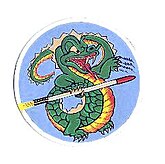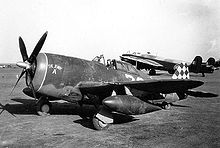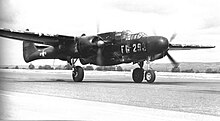318th Fighter-Interceptor Squadron
| 318th Fighter Interceptor Squadron | |
|---|---|
Air Force Outstanding Unit Award | |
| Insignia | |
| 318th Fighter Interceptor Squadron emblem[note 1][1][2] |  |
| 318th Fighter Squadron emblem[3][note 2][1] |  |
The 318th Fighter Interceptor Squadron is an inactive
McChord Air Force Base
, Washington, where it was inactivated on 7 December 1989.
The
Distinguished Unit Citations
before returning to the United States for inactivation.
The squadron was reactivated in 1947, serving in the
Pueblo Crisis
it deployed planes to Korea.
History
World War II
The

The squadron arrived in the
Distinguished Unit Citation for this action. In late September 1943, the squadron was withdrawn from combat to convert to Republic P-47 Thunderbolts and prepare to move to the Italian peninsula.[4]

By early December 1943, the squadron began to operate its Thunderbolts from
Lesina Airfield, Italy on the 29th of the month. However, on 30 January it flew its "T-Bolts" more than 300 miles at very low altitude to make a surprise attack on German interceptors defending airdromes near Villorba. The severe losses it inflicted on the defending forces enabled heavy bombers to attack vital targets in the area without encountering serious opposition. This action resulted in the second award of the Distinguished Unit Citation to the squadron.[4]

It escorted the
Vincenzo Airfield, Italy, remaining there until October, when it returned to the United States and was inactivated at Camp Kilmer, New Jersey on 28 October.[2][4]
Air Defense Command
Early operations


The squadron was reactivated in May 1947 at Mitchell Field, New York as an element of
Lockheed F-94A Starfire interceptors armed with 20 millimeter cannon, completing the upgrade by the end of the year.[6]
In June 1953, the squadron moved to
F-106 era

In March 1957, the squadron began a transition into supersonic
GAR-1 Falcons and equipped with data link for interception control through the Semi-Automatic Ground Environment system.[6] In March 1960, the 325th Fighter Group was inactivated and the squadron was assigned directly to the 325th Fighter Wing[2][10] The following month it upgraded to Convair F-106 Delta Darts.[6]
On 22 October 1962, before President
Paine Air Force Base at the start of the Cuban Missile Crisis. These planes returned to McChord after the crisis was over.[11][12]
1st Fighter-Interceptor Wing, which relieved it from March to June 1964. Operation White Shoes terminated in 1965 and the unit's planes returned home.[15]
On 11 February 1968, the 318th deployed to
48th Fighter-Interceptor Squadron, but its aircraft remained in Korea. As its personnel returned to the United States, they re-equipped with F-106s from the 48th.[16] The 325th Wing inactivated on 1 July 1968 as Military Airlift Command assumed responsibility for McChord, and the squadron was reassigned directly to the 25th Air Division.[17]
In 1970 and in 1984, the squadron won the
Northwest Orient Airlines flight, demanding ransom and threatening the passengers. Two F-106s from the squadron scrambled to trail the hijacked airliner.[19]
Final operations at McChord
The 318th converted to
194th Fighter-Interceptor Squadron of the California Air National Guard. The squadron remained at McChord until inactivating on 7 December 1989.[19]
Lineage
- Constituted as the 318th Fighter Squadron on 24 June 1942
- Activated on 3 August 1942
- Inactivated on 28 October 1945
- Activated on 21 May 1947
- Redesignated 318th Fighter Squadron (All Weather) on 10 May 1948
- Redesignated 318th Fighter-All Weather Squadron on 20 January 1950
- Redesignated 318th Fighter-Interceptor Squadron on 1 May 1951[20]
- Inactivated 7 December 1989[19]
Assignments
|
|
Stations
|
|
Aircraft
- Curtiss P-40 Warhawk, 1942–1943
- Republic P-47 Thunderbolt, 1943–1944
- North American P-51 Mustang, 1944–1945
- Northrop P-61 Black Widow, 1947–1948
- North American F-82 Twin Mustang, 1948–1951
- Lockheed F-94A Starfire, 1951–1954
- Northrop F-89D Scorpion, 1954–1955
- North American F-86D Sabre, 1955–1957
- Convair F-102 Delta Dagger, 1957–1960
- Lockheed T-33 Shooting Star, 1951–1988 (used as a proficiency trainer and practice "bogey" aircraft)
- Convair F-106 Delta Dart, 1960–1983[20]
- McDonnell Douglas F-15 Eagle, 1983–1989
Awards and campaigns
| Award streamer | Award | Dates | Notes |
|---|---|---|---|
| Presidential Unit Citation | 30 July 1943 | Sardinia, 318th Fighter Squadron[2] | |
| Presidential Unit Citation | 30 January 1944 | Italy, 318th Fighter Squadron[2] | |
Air Force Outstanding Unit Award |
1 June 1968-1 March 1968 | 318th Fighter-Interceptor Squadron[21] | |
| Air Force Outstanding Unit Award | 1 April 1972–30 June 1973 | 318th Fighter-Interceptor Squadron[22] | |
| Air Force Outstanding Unit Award | 1 July 1974–30 June 1976 | 318th Fighter-Interceptor Squadron[23] | |
| Air Force Outstanding Unit Award | 1 January 1983–1 June 1984 | 318th Fighter-Interceptor Squadron[23] | |
| Air Force Outstanding Unit Award | 1 July 1984–30 June 1986 | 318th Fighter-Interceptor Squadron[23] |
| Campaign Streamer | Campaign | Dates | Notes |
|---|---|---|---|
| Air Offensive, Europe | 28 February 1943–5 June 1944 | 318th Fighter Squadron[2] | |
| Air Combat, EAME Theater | 28 February 1943–11 May 1945 | 318th Fighter Squadron[2] | |
| Tunisia | 28 February 1943–13 May 1943 | 318th Fighter Squadron[2] | |
| Sicily | 14 May 1943–17 August 1943 | 318th Fighter Squadron[2] | |
| Naples-Foggia | 18 August 1943–21 January 1944 | 318th Fighter Squadron[2] | |
| Anzio | 22 January 1944–24 May 1944 | 318th Fighter Squadron[2] | |
| Rome-Arno | 22 January 1944–9 September 1944 | 318th Fighter Squadron[2] | |
| Normandy | 6 June 1944–24 July 1944 | 318th Fighter Squadron[2] | |
| Northern France | 25 July 1944–14 September 1944 | 318th Fighter Squadron[2] | |
| Southern France | 15 August 1944–14 September 1944 | 318th Fighter Squadron[2] | |
| North Apennines | 10 September 1944–4 April 1945 | 318th Fighter Squadron[2] | |
| Rhineland | 15 September 1944–21 March 1945 | 318th Fighter Squadron[2] | |
| Central Europe | 22 March 1944–21 May 1945 | 318th Fighter Squadron[2] | |
| Po Valley | 3 April 1945–8 May 1945 | 318th Fighter Squadron[2] |
See also
Wikimedia Commons has media related to 318th Fighter-All Weather Squadron.
References
Notes
- Explanatory notes
- ^ Approved 9 November 1955. Description: On a light blue disc, a Chinese Green Dragon with a fierce expression, body scales shadowed dark green, under the part of the body in rolled scales air force yellow and vermillion orange, his back barbed white, his eyeballs white with blood lines, claws, teeth, and fangs white outlined in his left hand emitting electronic rays, his right claw grasping a red tipped white rocket with black fins fire exhaust proper. According to Medieval History, the only way to slay the formable Green Dragon was to equip the bravest available man with a lance and stout armor plate. In modern times, this deadliest of all killers is equipped with rockets which again returns the "Green Dragon" to the position of the most dangerous opponent to man.
- ^ Approved 11 June 1943. Description: On a light blue disc, a Chinese Green Dragon, fangs and claws black, armored gold, mouth and tongue red, grasping a gray machine gun, emitting smoke from the barrel proper. Significance: According to Medieval History, the only way to slay the formable Green Dragon was to equip the bravest available man with a lance and stout armor plate. In modern times, this deadliest of all killers is equipped with a machine gun which again returns the "Green Dragon" to the position of the most dangerous opponent to man.
- ^ Aircraft is Northrop P-61B-20-NO Black Widow, serial 43-8293. Taken in 1947.
- ^ Aircraft is North American F-82F Twin Mustang, serial 46-426.
- ^ Aircraft is Convair F-102A-75-CO Delta Dagger 56-1420.
- ^ Aircraft is Convair F-106 Delta Dart 59-9.
- Citations
- ^ a b "318th Fighter-Interceptor Squadron: Emblem Description". 318th Fighter-Interceptor Squadron Green Dragons. Retrieved 14 December 2022.
- ^ a b c d e f g h i j k l m n o p q r s t u v w Maurer, Combat Squadrons, pp. 388–389
- ^ Watkins, p. 45
- ^ a b c d Maurer, Combat Units, pp. 206-208
- ^ Newton & Senning, pp. 597-598
- ^ a b c d Cornet & Johnson, p. 124
- ^ Maurer, Combat Squadrons, pp. 271-272, 388-389
- ^ Buss, et al., p. 6
- ^ Maurer, Combat Squadrons, pp. 571-572
- ^ Mueller, p. 395
- ^ McMullen, pp. 10–12
- ^ NORAD/CONAD Participation in the Cuban Missile Crisis, p. 16
- ^ McMullen, p. 27
- ^ McMullen, pp. 28–29
- ^ McMullen, pp. 32–34
- ^ "F-106 Delta Dart: Korea". F-106 Delta Dart: Ultimate Interceptor. Retrieved 15 December 2022.
- ^ a b "Factsheet 25 Air Division". Air Force Historical Research Agency. 5 October 2007. Archived from the original on 24 October 2012. Retrieved 9 April 2014.
- ^ "318th Fighter-Interceptor Squadron: Hughes Achievement Award". 318th Fighter-Interceptor Squadron Green Dragons. Retrieved 14 December 2022.
- ^ a b c d "318th Fighter-Interceptor Squadron: Green Dragons". F-106 Delta Dart: Ultimate Interceptor. Retrieved 14 December 2022.
- ^ a b c d Lineage through March 1963 in Maurer, Combat Squadrons, pp. 388–389
- ^ AF Pamphlet 900-2, Vol, 1, p. 314
- ^ AF Pamphlet 900-2, Vol, 2, p. 59
- ^ a b c "Air Force Personnel Services: Unit Awards". Air Force Personnel Center. Retrieved 8 December 2022. (search)
Bibliography
![]() This article incorporates public domain material from the Air Force Historical Research Agency
This article incorporates public domain material from the Air Force Historical Research Agency
- Buss, Lydus H.(ed), Sturm, Thomas A., Volan, Denys, and McMullen, Richard F., History of Continental Air Defense Command and Air Defense Command July to December 1955, Directorate of Historical Services, Air Defense Command, Ent AFB, CO, (1956)
- Cornett, Lloyd H.; Johnson, Mildred W. (1980). A Handbook of Aerospace Defense Organization, 1946–1980 (PDF). Peterson AFB, CO: Office of History, Aerospace Defense Center. Archived from the original (PDF) on 13 February 2016. Retrieved 28 February 2014.
- Maurer, Maurer, ed. (1983) [1961]. Air Force Combat Units of World War II (PDF) (reprint ed.). Washington, DC: Office of Air Force History. LCCN 61060979. Retrieved 17 December 2016.
- Maurer, Maurer, ed. (1982) [1969]. Combat Squadrons of the Air Force, World War II (PDF) (reprint ed.). Washington, DC: Office of Air Force History. OCLC 72556.
- McMullen, Richard F. (1964) "The Fighter Interceptor Force 1962–1964" ADC Historical Study No. 27, Air Defense Command, Ent Air Force Base, CO (Confidential, declassified 22 March 2000)
- Mueller, Robert (1989). Air Force Bases, Vol. I, Active Air Force Bases Within the United States of America on 17 September 1982 (PDF). Washington, DC: Office of Air Force History. ISBN 0-912799-53-6. Retrieved 17 December 2016.
- Newton, Wesely P. Jr.; Senning, Calvin F. (1963). "USAF Credits for the Destruction of Enemy Aircraft, World War II, USAF Historical Study No. 85" (PDF). Research Studies Institute, USAF Historical Division, Air University. Retrieved 27 July 2022.
- Watkins, Robert A. (2009). Insignia and Aircraft Markings of the U.S. Army Air Force In World War II. Vol. IV, European-African-Middle Eastern Theater of Operations. Atglen,PA: Shiffer Publishing, Ltd. ISBN 978-0-7643-3401-6.
- NORAD/CONAD Participation in the Cuban Missile Crisis, Historical Reference Paper No. 8, Directorate of Command History Continental Air Defense Command, Ent AFB, CO, 1 Feb 63 (Top Secret NOFORN declassified 9 March 1996)
- "AF Pamphlet 900-2, Unit Decorations, Awards and Campaign Participation Credits" (PDF). Washington, DC: Department of the Air Force Index. 15 June 1971. Archived from the original (PDF) on 4 August 2015. Retrieved 11 August 2016.
- "AF Pamphlet 900-2, Unit Decorations, Awards and Campaign Participation Credits, Vol II" (PDF). Washington, DC: Department of the Air Force. 30 September 1976. Archived from the original (PDF) on 4 August 2015. Retrieved 11 August 2016.
- Further reading
- Pape, Garry R.; Campbell, John M.; Campbell, Donna (1991). Northrop P-61 Black Widow: The Complete History and Combat Record. Minneapolis, MN: Motorbooks International. ISBN 978-0-879385-09-5.
- "ADCOM's Fighter Interceptor Squadrons". The Interceptor. 21 (1). Aerospace Defense Command: 5–11, 26–31, 40–45, 54–59. January 1979.

